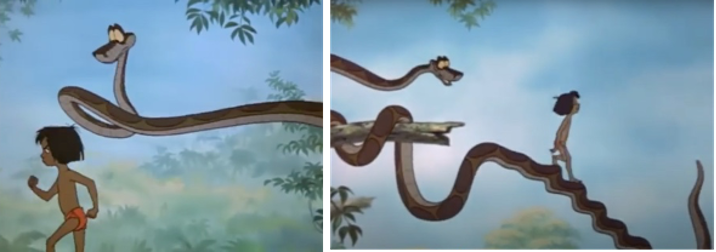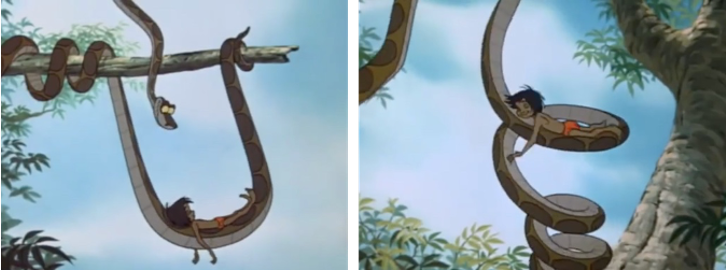The notorious Kaa was manipulated in the Jungle Book[1] (1967) to serve the role of an antagonist, an inversion on his portrayal from Kipling’s original books[2] (1894). Kaa is presented as the enchanting reptile that adheres to the stereotypes of an Indian Rock Python.Reitherman harnesses the trance-like song “Trust in Me”[3] to ironically expose his deceitful nature and exemplify villainy. Accelerated by the parallels to traditional snake-charmer music, the song becomes significant in exploring the standardised views of a snake and portraying notions of enchantment. The soothing song resonates a lullaby that induces sleep and the mise-en-scene almost displays a dream sequence that shows the snake having power over the man-cub. The lexis of Kaa holds sibilant tones to reflect hissing sounds, intertwined alongside his sly movements the scene serves to reinforce animality constructs and emphasise mesmerizing tendencies. Kaa’s eyes appear humorously as psychedelic symbols to convey the idea of hypnosis which is significant in connoting temptation. The seductive eyes displayed below through a window, suggest that Kaa is coaxing Mowgli into a trap, but he also functions as a signifier in exploiting human superiority – the framing around him suggests a theme of animal imprisonment. Reitherman could be exposing the ways in which humans exploit snakes as an entertainment form by entrapping Kaa inside the window of the frame.

The deceit of Kaa contrasts interactions from previous scenes, the human-animal binary is re-established as a power struggle comes into play. Jungle Book offers a role reversal of a human in the animal world, however Kaa’s comic inability to kill Mowgli highlights anthropocentrism. Positioning is salient in denoting the power hierarchy, the mise-en-scene always depicts Kaa’s head as physically above Mowgli therefore showing that Kaa has the control in the sequence.
As a scene displaying a story of temptation, Kaa hisses: – “You have just sealed your doom”[3] which echoes Miltonic analysis on the downfall of Man in ‘Paradise Lost’[4]. Exposed in Kaa’s bodily positioning the referred doom lies analogous to human subordination. Kaa highlights an extended motif of death by coiling his body into specific shapes, initially a noose which Mowgli has to keep removing from around his head. The imagery heightens the inevitable sense of fate for mankind; Kaa constructs a staircase which symbolises a descent that would see mankind as inferior to animals.

The effortless shape transitions illustrate the inexorable nature of downfall. Kaa weaves in and out to become a hammock, which symbolises a notion of eternal slumber and a state of relaxed entrapment, Kaa has thus subverted the human-animal dynamic. In addition, the helter skelter accentuates the spiralling downfall of humanity. Kaa’s positioning as a helter skelter for Mowgli to slide down expresses Man’s fall from grace; it is unstoppable until reaching the bottom. Mowgli’s naivety to the dangers of Kaa satirically conveys a microcosmic view that man is unthreatened by the existence of animality, instead Mowgli effortlessly pushes Kaa away and jeers at animal adversity when he becomes objectified by a knot in his tail.

References:
1 Reitherman, Wolfgang, dir., The Jungle Book (United Kingdom: Buena Vista Distribution, Walt Disney 1968)
2 Kipling, Rudyard, The Jungle Book (Great Britain: Pan Books Ltd, 1975)
3 Smith, Nicole, No Escape This Time, online video, YouTube, 18 April 2014 <https://www.youtube.com/watch?v=EEWMTUEOQqI> [Accessed 20/04/2020]
4 Milton, John, Paradise Lost, eBook 26 (February 1992) Project Gutenberg <http://www.gutenberg.org/cache/epub/26/pg26-images.html> [Accessed 20/04/2020]